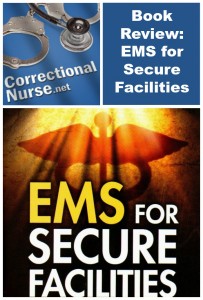 Recently I noticed that Amazon is pairing our book, Essentials of Correctional Nursing, with the book EMS for Secure Facilities by Joseph Grafft and Ricard Sarff. I decided it would be a good idea to check the book out and here is my review.
Recently I noticed that Amazon is pairing our book, Essentials of Correctional Nursing, with the book EMS for Secure Facilities by Joseph Grafft and Ricard Sarff. I decided it would be a good idea to check the book out and here is my review.
EMS for Secure Facilities is a 188 page softcover published by DelMar Cengage in 2012 as a workbook for new corrections employees who need to know how to respond to an emergency within the security perimeter. The authors have extensive corrections background in the Minnesota Department of Corrections. The book has a companion instructor resources CD as a separate purchase.
Advantages: This book is helpful for those new to a correctional setting and even to health care in general. It is primarily focused on the new corrections officer who may not even know proper hand washing technique (which is described in text and graphics). The introductory chapters include some basic emergency assessment mnemonics that can be very helpful including AVPU (alert, verbal response, pain response, unresponsive) for level of consciousness and SAMPLE (signs/symptoms, allergies, medications, past medical history, last oral intake, events leading to injury/illness) for background information. The book also covers basic first aid for a variety of common medical emergencies such as allergy, cardiac events, respiratory distress, and seizures. The first chapter provides safety information including the need to secure a scene before rendering care. There is a chapter on considerations when preparing the inmate for transport out of the facility. Each chapter includes practice scenarios for the reader to apply information covered in the chapter.
Disadvantages: The book does not fully cover emergencies that might be unique to the correctional setting and therefore of particular interest to new correctional nurses. For example, the section that discusses suicide does not provide interventions for a hanging response and only includes hanging as a case study without answers. This is a particular issue for nurses who want to know what to do when they enter a cell with a hanging in progress. In addition, the mental health section does not cover non-life threatening self-injury in any detail. This is another nursing concern fairly unique to corrections. Possibly because the authors are from a prison setting, the book does not address alcohol and drug withdrawal emergencies such as delirum.
As a general emergency response manual for prison employees, this text hits the mark. It would be very helpful in a training academy setting, for which it was targeted. Correctional nurses, however, will probably find it lacking in the details they need for their own practice. However, I commend the authors and the publisher for getting this information into print as we are sorely lacking resources in our specialty of correctional healthcare and custody officers partner with correctional nurses in delivering emergency care.
Catherine Knox says
I saw this book coupled with the Essentials of Correctional Nursing on the Amazon page and wondered what relationship there was between the two texts. Your review of this book answers that question. It is great to have resources like this becoming available to the professionals providing services in correctional facilities.